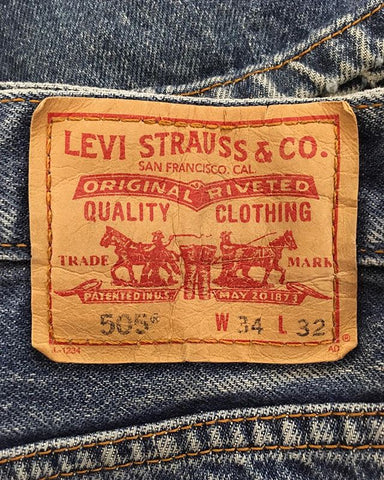The History of Levi's Jeans
How many pairs of jeans have you seen today? On the street, at work, or when you went to grab something to eat? It’s impossible to say. There are said to be the equivalent of 7 pairs of jeans per person in the world and the US produces up to 450 million of them alone every year. But when were the humble jeans born? Like all good spaghetti westerns, at the end of a dusty road that stretched between San Francisco and the Arizona border. Here is a brief history of the Levi's brand!
When was Levis Created?
The year is 1873. For the past 20 years the Levi Strauss company, founded by a German Jewish immigrant had been supplying the general stores of the West, where cowboys got their supplies. Levi’s Strauss was a wholesaler and sold everything from shovels, picks, lanterns, pots and pans, shoes, long johns, shirts and dungarees.
The dungarees were usually made out of blue canvas, denim. Strauss thought he would spend his life being a dry goods wholesalers until one day in 1872 Strauss received a letter from one of his clients, Mr Jacob Davis;
Dear Mr Strauss,
Today one of my female clients came in today to my shop complaining the area around the pockets on your dungarees are not sturdy enough. Dungarees that my client's husband keeps his gold digging tools in. At that precise moment I was attaching leather straps on a horse blanket using brass rivets and it gave me an idea......
Jacob Davis wanted to patent using brass rivets on canvas workwear but needed a business partner and in May 1873 together with Strauss, they got that patent.
With the pockets in canvas trousers now secure, the jean was born, or as they were known then, the XX. (extra, extra strong.) This was significantly important. Men who bought jeans were labourers and workmen who needed their clothes to last longer. It saved them money and it protected them.
Strauss then had another idea. Above the back pocket, they would sew a leather patch that all could see with a drawing of two horses trying to pull apart a pair of jeans. It was an innovative concept. Levi’s clients at the time were cowboys, farmers, and workers who were mostly illiterate so when they went to buy a pair of jeans all they had to do was ask for the pair with two horses.

The history of the ‘Nevada’ jeans
A lesser known part of the Levis history is the ‘Nevada’ jean. One of the earliest designs from Straus and Davis, (Levis Strauss & Co) this jean was nicknamed the ‘Nevada’ after a pair was discovered at the bottom of a mineshaft in 1998, dating from 1879.
In 2001 the ‘Nevada’ was put up for sale on eBay. Bidding was fierce and a rumour of one of the people trying to buy the jeans off eBay was Ralph Lauren. Levi’s wanted them for their archive and they won with the winning bid of $46,532 dollars. In 1879 the same pair were sold at 99 cents, they looked like any early Levi jean, waistband, crotch rivet, a cinch and suspender buttons.
The ‘Nevada’ also included a unique knife pocket on the rear outer of the left leg. As these jeans were created before the invention of the double stitch sewing machine, the distinctive arcuate (bow-shaped) stitching on the pockets will have been stitched twice using a hand-mechanised, single stitch machine, giving it a unique character.

In 2001 after the winning bid, Levis celebrated its return with a reproduction of the ‘Nevada,’ complete with the shopping and distressing of the original. With only the 501 created they have become a collector's item almost as much as the original.
These are the oldest pair of jeans in existence, If you look at them from the front they look like the perfectly fashioned jeans. No one would know that they are 139 years old. Yet if you were to wear general men’s clothing from 1879 people would say, where is the costume party?
What about the History of Black Levis Jeans?
When looking at the history of Levi’s jeans it's roots are buried deep in the realms of Indigo dye and the classic blue jean, however, it was Levi's that created the black jeans that are now present-day rivals to blue jeans.
In 1956 Elvis Presley Starred in the film, Jailhouse Rock. Featured in the movie was an experiment from Levis - black denim. Originally named, Levis 'Elvis Presley' jeans, they were aimed at the youth market. Ironically Elvis actually disliked jeans but this moment in Cinema holds huge significance in fashion and culture.
Firstly the birth of the black jean which has become a style icon in its own right. Secondly, Levis association with Elvis Presley and their endorsement with Jailhouse Rock made a significant contribution to jeans becoming a must-have item for the youth of the 1950s, helping Levis to compete against Lee who had the endorsement of James Dean who wore Lee 101s in Rebel without a cause.
What is the small pocket on the front of Levi's for?
The small pocket on the front of Levi’s can often be questioned for its functionality and purpose. Originally it was designed for cowboys and lumberjacks who kept their pocket watches in them. Then it came to the place to slip matches and lighters in. Today it is often defunct, the home of loose change or condoms. The pocket of safe sex! What do you keep in yours?
Discover our selection of amazing Levi’s online and in-store, stay tuned for more Levi Strauss history blogs, and read about all you’ll need to know on the incredible 500 series here.










